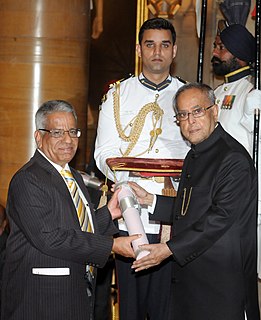Related Research Articles

In physics and engineering, fluid dynamics is a subdiscipline of fluid mechanics that describes the flow of fluids—liquids and gases. It has several subdisciplines, including aerodynamics and hydrodynamics. Fluid dynamics has a wide range of applications, including calculating forces and moments on aircraft, determining the mass flow rate of petroleum through pipelines, predicting weather patterns, understanding nebulae in interstellar space and modelling fission weapon detonation.
In fluid dynamics, turbulence or turbulent flow is fluid motion characterized by chaotic changes in pressure and flow velocity. It is in contrast to a laminar flow, which occurs when a fluid flows in parallel layers, with no disruption between those layers.
In fluid dynamics, the Darcy–Weisbach equation is an empirical equation, which relates the head loss, or pressure loss, due to friction along a given length of pipe to the average velocity of the fluid flow for an incompressible fluid. The equation is named after Henry Darcy and Julius Weisbach.

Computational fluid dynamics (CFD) is a branch of fluid mechanics that uses numerical analysis and data structures to analyze and solve problems that involve fluid flows. Computers are used to perform the calculations required to simulate the free-stream flow of the fluid, and the interaction of the fluid with surfaces defined by boundary conditions. With high-speed supercomputers, better solutions can be achieved, and are often required to solve the largest and most complex problems. Ongoing research yields software that improves the accuracy and speed of complex simulation scenarios such as transonic or turbulent flows. Initial validation of such software is typically performed using experimental apparatus such as wind tunnels. In addition, previously performed analytical or empirical analysis of a particular problem can be used for comparison. A final validation is often performed using full-scale testing, such as flight tests.
In viscous fluid dynamics, the Archimedes number (Ar), named after the ancient Greek scientist Archimedes is used to determine the motion of fluids due to density differences. It is a dimensionless number, the ratio of gravitational forces to viscous forces and has the form:

A fluidized bed is a physical phenomenon occurring when a quantity of a solid particulate substance is placed under appropriate conditions to cause a solid/fluid mixture to behave as a fluid. This is usually achieved by the introduction of pressurized fluid through the particulate medium. This results in the medium then having many properties and characteristics of normal fluids, such as the ability to free-flow under gravity, or to be pumped using fluid type technologies.
Turbulence modeling is the construction and use of a mathematical model to predict the effects of turbulence. Turbulent flows are commonplace in most real life scenarios, including the flow of blood through the cardiovascular system, the airflow over an aircraft wing, the re-entry of space vehicles, besides others. In spite of decades of research, there is no analytical theory to predict the evolution of these turbulent flows. The equations governing turbulent flows can only be solved directly for simple cases of flow. For most real life turbulent flows, CFD simulations use turbulent models to predict the evolution of turbulence. These turbulence models are simplified constitutive equations that predict the statistical evolution of turbulent flows.

The Stokes number (Stk), named after George Gabriel Stokes, is a dimensionless number characterising the behavior of particles suspended in a fluid flow. The Stokes number is defined as the ratio of the characteristic time of a particle to a characteristic time of the flow or of an obstacle, or

In fluid mechanics, multiphase flow is the simultaneous flow of materials with two or more thermodynamic phases. Virtually all processing technologies from cavitating pumps and turbines to paper-making and the construction of plastics involve some form of multiphase flow. It is also prevalent in many natural phenomena.

A multifractal system is a generalization of a fractal system in which a single exponent is not enough to describe its dynamics; instead, a continuous spectrum of exponents is needed.

A bedform is a feature that develops at the interface of fluid and a moveable bed, the result of bed material being moved by fluid flow. Examples include ripples and dunes on the bed of a river. Bedforms are often preserved in the rock record as a result of being present in a depositional setting. Bedforms are often characteristic to the flow parameters, and may be used to infer flow depth and velocity, and therefore the Froude number.

The Reynolds number is an important dimensionless quantity in fluid mechanics used to help predict flow patterns in different fluid flow situations. At low Reynolds numbers, flows tend to be dominated by laminar (sheet-like) flow, while at high Reynolds numbers turbulence results from differences in the fluid's speed and direction, which may sometimes intersect or even move counter to the overall direction of the flow. These eddy currents begin to churn the flow, using up energy in the process, which for liquids increases the chances of cavitation. The Reynolds number has wide applications, ranging from liquid flow in a pipe to the passage of air over an aircraft wing. It is used to predict the transition from laminar to turbulent flow, and is used in the scaling of similar but different-sized flow situations, such as between an aircraft model in a wind tunnel and the full size version. The predictions of the onset of turbulence and the ability to calculate scaling effects can be used to help predict fluid behaviour on a larger scale, such as in local or global air or water movement and thereby the associated meteorological and climatological effects.
Particle-laden flows refers to a class of two-phase fluid flow, in which one of the phases is continuously connected and the other phase is made up of small, immiscible, and typically dilute particles. Fine aerosol particles in air is an example of a particle-laden flow; the aerosols are the dispersed phase, and the air is the carrier phase.
Slip ratio in gas–liquid (two-phase) flow, is defined as the ratio of the velocity of the gas phase to the velocity of the liquid phase.
The eddy break-up model (EBU) is used in combustion engineering. Combustion modeling has a wide range of applications. In most of the combustion systems, fuel and oxygen are separately supplied in the combustion chamber. Due to this, chemical reaction and combustion occurs simultaneously in the combustion chamber. However, the rate of the chemical reaction is faster than the rate of mixing fuel and oxygen. Therefore, that rate of combustion is controlled by rate of mixing. Such cases, where formation of pre-mixture is difficult, are called diffusion combustion or diffusion flames.
K-epsilon (k-ε) turbulence model is the most common model used in Computational Fluid Dynamics (CFD) to simulate mean flow characteristics for turbulent flow conditions. It is a two equation model that gives a general description of turbulence by means of two transport equations (PDEs). The original impetus for the K-epsilon model was to improve the mixing-length model, as well as to find an alternative to algebraically prescribing turbulent length scales in moderate to high complexity flows.
Reynolds stress equation model (RSM), also referred to as second moment closures are the most complete classical turbulence model. In these models, the eddy-viscosity hypothesis is avoided and the individual components of the Reynolds stress tensor are directly computed. These models use the exact Reynolds stress transport equation for their formulation. They account for the directional effects of the Reynolds stresses and the complex interactions in turbulent flows. Reynolds stress models offer significantly better accuracy than eddy-viscosity based turbulence models, while being computationally cheaper than Direct Numerical Simulations (DNS) and Large Eddy Simulations.

Jyeshtharaj Bhalchandra Joshi is an Indian chemical engineer, nuclear scientist, consultant and teacher, widely known for his innovations in nuclear reactor designs and generally regarded as a respected teacher. He is the DAE-Homi Bhabha Chair Professor, Homi Bhabha National Institute, Mumbai, and is the recipient of Shantiswarup Bhatnagar Prize for Engineering Sciences and many other awards and recognitions. He received the third highest civilian honour, the Padma Bhushan, in 2014 for his services to the field of chemical engineering and nuclear science.
Electrical capacitance volume tomography (ECVT) is a non-invasive 3D imaging technology applied primarily to multiphase flows. It was first introduced by W. Warsito, Q. Marashdeh, and L.-S. Fan as an extension of the conventional electrical capacitance tomography (ECT). In conventional ECT, sensor plates are distributed around a surface of interest. Measured capacitance between plate combinations is used to reconstruct 2D images (tomograms) of material distribution. In ECT, the fringing field from the edges of the plates is viewed as a source of distortion to the final reconstructed image and is thus mitigated by guard electrodes. ECVT exploits this fringing field and expands it through 3D sensor designs that deliberately establish an electric field variation in all three dimensions. The image reconstruction algorithms are similar in nature to ECT; nevertheless, the reconstruction problem in ECVT is more complicated. The sensitivity matrix of an ECVT sensor is more ill-conditioned and the overall reconstruction problem is more ill-posed compared to ECT. The ECVT approach to sensor design allows direct 3D imaging of the outrounded geometry. This is different than 3D-ECT that relies on stacking images from individual ECT sensors. 3D-ECT can also be accomplished by stacking frames from a sequence of time intervals of ECT measurements. Because the ECT sensor plates are required to have lengths on the order of the domain cross-section, 3D-ECT does not provide the required resolution in the axial dimension. ECVT solves this problem by going directly to the image reconstruction and avoiding the stacking approach. This is accomplished by using a sensor that is inherently three-dimensional.

Charles Meneveau is a French-Chilean born American fluid dynamicist, known for his work on turbulence, including turbulence modeling and computational fluid dynamics.
References
- Montoya, G.; Liao, Y.; Lucas, D.; Krepper, E. "Analysis and Applications of a Two-Fluid Multi-Field Hydrodynamic Model for Churn-Turbulent Flows", 21st International Conference on Nuclear Engineering – ICONE 21. China (2013)
- Montoya, G.; Baglietto, E.; Lucas, D.; Krepper, E. "A Generalized Multi-Field Two-Fluid Approach for Treatment of Multi-Scale Interfacial Structures in High Void-Fraction Regimes", MIT Energy Night 2013. Cambridge, Massachusetts, USA (2013)
•Montoya, G.; Lucas, D.; Krepper, E.; Hänsch, S.; Baglietto, E. Analysis and Applications of a Generalized Multi-Field Two-Fluid Approach for Treatment of Multi-Scale Interfacial Structures in High Void-Fraction Regimes 2014 International Congress on Advances in Nuclear Power Plants – ICAPP 2014. USA (2014) •Montoya, G.; Baglietto, E.; Lucas, D.; Krepper, E.; Hoehne, T. Comparative Analysis of High Void Fraction Regimes using an Averaging Euler-Euler Multi-Fluid Approach and a Generalized Two-Phase Flow (GENTOP) Concept 22nd International Conference on Nuclear Engineering – ICONE 22. Czech Republic (2014)
- Montoya, G.; Baglietto, E.; Lucas, D.; Krepper, E.
Development and Analysis of a CMFD Generalized Multi-Field Model for Treatment of Different Interfacial Scales in Churn-Turbulent and Transitional Flows CFD4NRS-5 – Application of CFD/CMFD Codes to Nuclear Reactor Safety Design and their Experimental Validation. Switzerland (2014)
- https://www.hzdr.de/db/!Publications?pSelTitle=18077&pSelMenu=-1&pNid=3016
- Shuiqing Zhan, Mao Li, Jiemin Zhou, Jianhong YangYiwen Zhou Applied Thermal Engineering 2014, 73, 803–816 [CrossRef]
- T. T. DeviB. Kumar Thermophysics and Aeromechanics 2014, 21, 365–382 [CrossRef]
- R.M.A. MasoodA. Delgado Chemical Engineering Science 2014, 108, 154–168 [CrossRef]
- ×M. Pourtousi, J.N. SahuP. Ganesan Chemical Engineering and Processing: Process Intensification 2014, 75, 38–47 [CrossRef]
- ↑ • Lijia Xu, Zihong Xia, Xiaofeng Guo, and Caixia Chen Industrial & Engineering Chemistry Research 2014, 53 (12), 4922-4930 [ACS Full Text ] [PDF (1741 KB)] [PDF w/ Links (526 KB)]